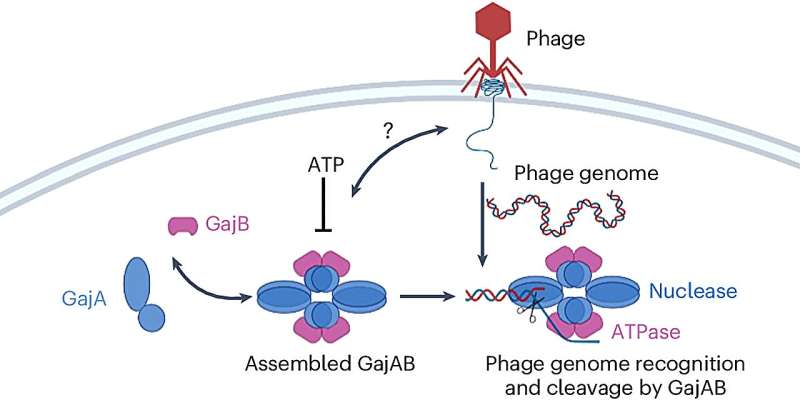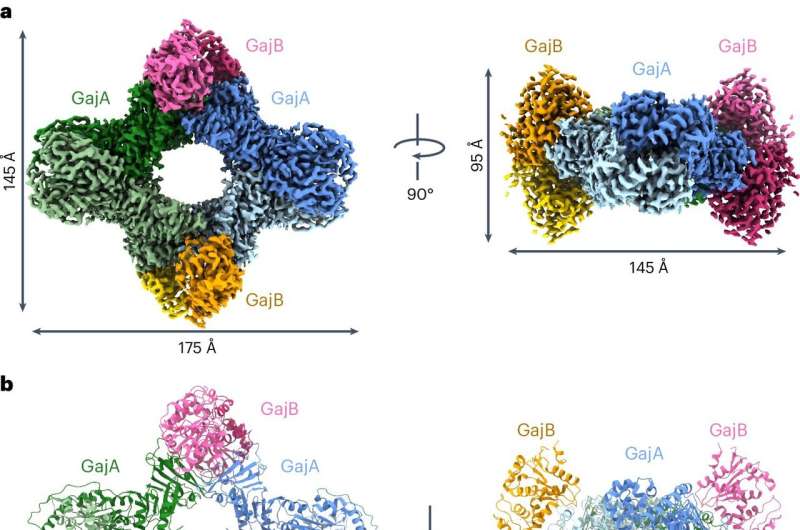This article has been reviewed according to Science X's editorial process and policies. Editors have highlighted the following attributes while ensuring the content's credibility:
fact-checked
peer-reviewed publication
trusted source
proofread
Study details a common bacterial defense against viral infection

One of the many secrets to bacteria's success is their ability to defend themselves from viruses, called phages, that infect bacteria and use their cellular machinery to make copies of themselves.
Technological advances have enabled recent identification of the proteins involved in these systems, but scientists are still digging deeper into what those proteins do.
In a new study, a team from The Ohio State University has reported on the molecular assembly of one of the most common anti-phage systems—from the family of proteins called Gabija—that is estimated to be used by at least 8.5%, and up to 18%, of all bacteria species on Earth.
Researchers found that one protein appears to have the power to fend off a phage, but when it binds to a partner protein, the resulting complex is highly adept at snipping the genome of an invading phage to render it unable to replicate.
"We think the two proteins need to form the complex to play a role in phage prevention, but we also believe one protein alone does have some anti-phage function," said Zhangfei Shen, co-lead author of the study and a postdoctoral scholar in biological chemistry and pharmacology at Ohio State's College of Medicine. "The full role of the second protein needs to be further studied."
The findings add to scientific understanding of microorganisms' evolutionary strategies and could one day be translated into biomedical applications, researchers say.
Shen and co-lead author Xiaoyuan Yang, a Ph.D. student, work in the lab of senior author Tianmin Fu, assistant professor of biological chemistry and pharmacology at Ohio State.
The study was published April 16 in Nature Structural & Molecular Biology.

The two proteins that make up this defense system are called Gabija A and Gabija B, or GajA and GajB for short.
Researchers used cryo-electron microscopy to determine the biochemical structures of GajA and GajB individually and of what is called a supramolecular complex, GajAB, created when the two bind to form a cluster consisting of four molecules from each protein.
In experiments using Bacillus cereus bacteria as a model, researchers observed the activity of the complex in the presence of phages to gain insight into how the defense system works.
Though GajA alone showed signs of activity that could disable a phage's DNA, the complex it formed with GajB was much more effective at ensuring phages would not be able take over the bacterial cell.
"That's the mysterious part," Yang said. "GajA alone is sufficient to cleave the phage nucleus, but it also does form the complex with GajB when we incubate them together. Our hypothesis is that GajA recognizes the phage's genomic sequence, but GajB enhances that recognition and helps to cut the phage DNA."
The large size and elongated configuration of the complex made it difficult to get the full picture of GajB's functional contributions when bound to GajA, Shen said, leaving the team to make some assumptions about protein roles that have yet to be confirmed.
"We only know GajB helps enhance GajA activity, but we don't yet know how it works because we only see about 50% of it on the complex," Shen said.
One of their hypotheses is that GajB may influence the concentration level of an energy source, the nucleotide ATP (adenosine triphosphate), in the cellular environment—specifically, by driving ATP down upon detection of the phage's presence. That would have the dual effect of expanding GajA's phage DNA-disabling activity and stealing energy that a phage would need to start replicating, Yang said.
There is more to learn about bacterial anti-phage defense systems, but this team has already shown that blocking virus replication isn't the only weapon in the bacterial arsenal. In a previous study, Fu, Shen, Yang and colleagues described a different defense strategy: bacteria programming their own death rather than letting phages take over a community.
More information: Xiao-Yuan Yang et al, Molecular basis of Gabija anti-phage supramolecular assemblies, Nature Structural & Molecular Biology (2024). DOI: 10.1038/s41594-024-01283-w
Journal information: Nature Structural & Molecular Biology
Provided by The Ohio State University





















